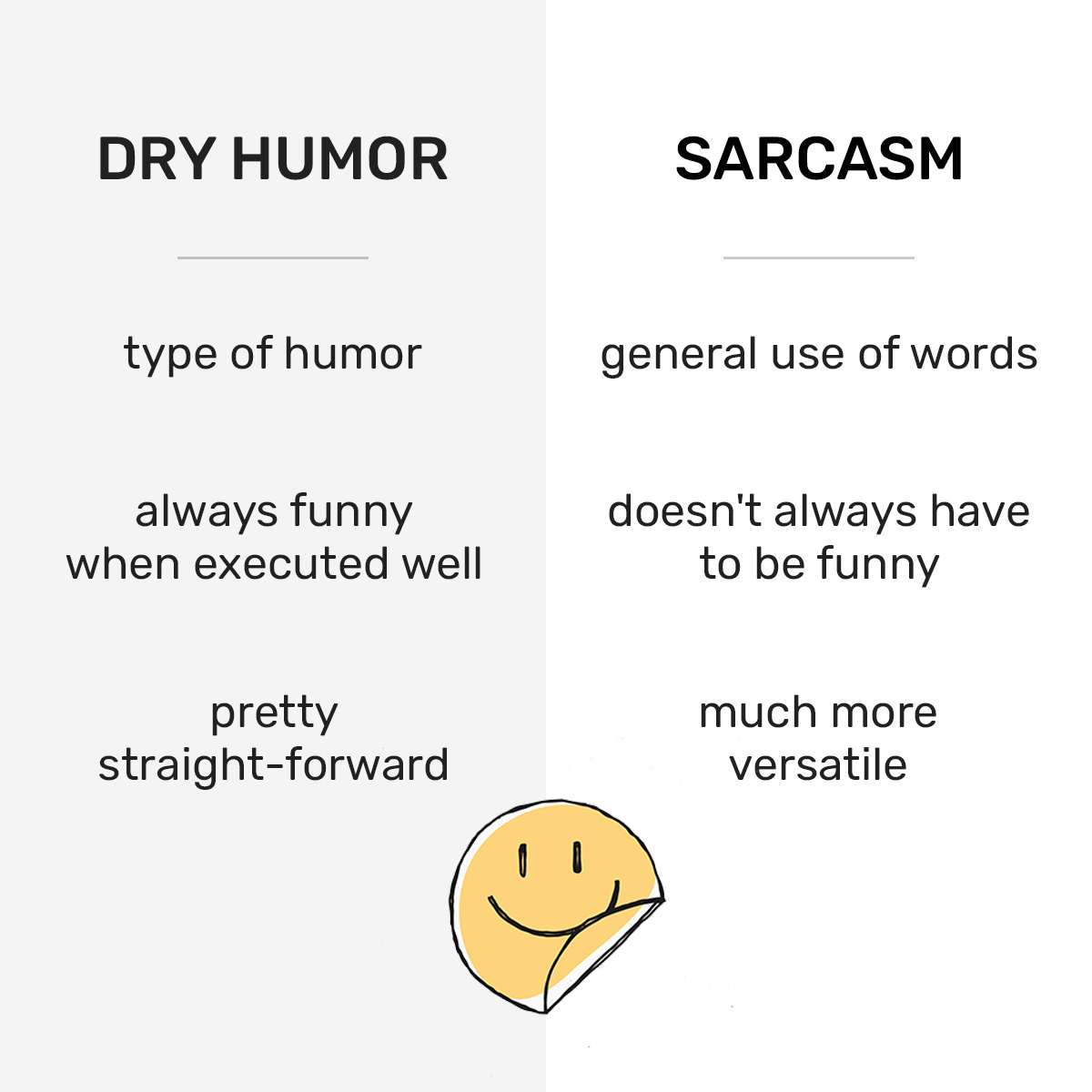Humor is a strength, no matter how you put it, and it comes in all shapes and forms.
Some people display humor through hilarious impressions. Others use references, and still, others enjoy taking digs at those around them.
We have already covered the different types of humor on our blog. Today, we are focusing on what particular kind and answering the question – what is dry humor?
In this post, we’re going to give you a complete, comprehensive guide to deadpan comedy, along with a bunch of examples. By the end of it, you will have a full understanding of the topic, and you will learn how to be better at dry humor if it is your thing.
Let’s get started!

What is Dry Humor?
First things first – we need to understand the basics and define dry humor.
Dry humor (also known as deadpan) is a unique type of humor that uses a lack of emotion and facial expressions to highlight the absurdity of the joke.
The contrast between the delivery and the humorous intention behind the words is what makes it so funny!
The delivery style of dry humor is typically blunt, ironic, laconic, or appears unintentional.
Unlike slapstick or low-brow humor, which rely on physical comedy, gross-out elements, or shock value to elicit a reaction, dry humor is a more sophisticated type of humor. It requires a level of intelligence and wit to appreciate and understand.
But, where does the name come from?
Dry Humor Meaning – What is Deadpan?
We won’t bore you with many historical details here. Even if we wanted to, the truth is – there aren’t many.
The word is quite old, and New York Times first used it in one of their articles back in the 1920s.
It is a combination of two words:
- dead – which refers to the lack of emotion we mentioned before,
- and pan – which is slang for face.
As straightforward as it gets, deadpan comedy is humor delivered with a straight, expressionless face, which is an incredibly important point about dry humor.
Here, most people have a reasonable question that comes to mind when you first hear about dry humor:
Isn’t it the same as sarcasm?
Not exactly.
Dry Humor vs Sarcasm

Now that we understand the dry sense of humor meaning, we can look into the general differences between sarcasm and deadpan.
The main difference between dry sense of humor vs sarcasm is that sarcasm isn’t always funny, and people don’t always use it for comedic purposes.
While it certainly can be hilarious, sarcasm mostly revolves around saying things that are the opposite of what you truly mean. That is why we usually say sarcastic comments using a recognizable, ironic tone.
It is also the reason why it is hard to distinguish it in written form. Once you remove the delivery, you can never be sure if the person is serious or not.
The importance of delivery is common for both dry humor and sarcasm, making it hard to differentiate them.
However, here is a quick cheat sheet that will help you know the difference with certainty:
- Dry humor is all about the presentation. Sarcasm focuses on the intention behind the words.
- Sarcasm can be loud, funny, annoying, or even dry. Dry humor is always, well – dry.
- Dry humor, if well-executed, is always funny. Sarcasm doesn’t always have to be. People sometimes use it to mock or annoy others, and it can quickly evolve into an irritating trait if overused.
- However, sarcasm is one of the core tools used in dry humor.
Don’t get us wrong – there is nothing wrong with sarcasm in general. There are many incredibly funny, sarcastic people out there. Everyone who has watched Friends at one point in their lives can agree that Chandler is a character who is impossible not to love.
However, sarcasm can have an ugly side, depending on how you use it. There is even a funny quote about it:
Sarcasm is like cheap wine – it leaves a terrible aftertaste.
━Dana Perino
A quick recap:

Hopefully, the difference is clear by now, and we can go back to exploring the beauty of deadpan humor.
The Delivery of Dry Humor
The delivery is the core of deadpan comedy, just as with most other types of humor. However, here it plays an even more important role.
Without proper delivery, most of the dry humor jokes would:
- go completely unnoticed,
- look and sound like rude comments or even insults,
- sound out of context and end up entirely misunderstood,
- people will think it’s maybe an inside joke.
For that reason, a point to keep in mind is that dry humor is not as simple to carry out as it appears in theory. It is a unique art that is one of its kind, and many things make it so.
Every great deadpan comedian displays a mastery of gestures, expressions, and words they use to get their point across.
Elements of Dry Humor
Deadpan has several elements that distinguish it from other types of humor. Below are some of the key characteristics of dry humor:
- Wit: Dry humor often relies on clever wordplay and puns to elicit laughter.
- Sarcasm: A critical component of dry humor, sarcasm involves saying the opposite of what you mean in a manner that is intended to be amusing.
- Irony: Irony involves expressing or performing something that is unexpected or contradictory in a way that is meant to be humorous.
- Deadpan Delivery: Dry humor is often delivered in a deadpan manner, with little or no emotion. This adds to the humor’s unpredictability and surprise.
Another crucial aspect of dry humor is that it frequently involves mocking serious or taboo subjects, such as politics, religion, and social norms. However, it is important to remember that dry humor should never be used to harm or offend others.
Now that we got the basics down, let’s dive into the most important aspects right away.
How to Tell if You Have a Dry Sense of Humor
Even though you understand what is a dry sense of humor by now, how can you be absolutely certain that you have it? Here is a quick rundown of the telltale signs:
- Your facial expressions and body language are minimal when telling jokes. Instead, the tone, delivery, and subtlety are your cup of tea, and you mastered the deadpan expression a long time ago.
- Your poker face is helpful in many areas of your life, especially stressful or uncomfortable situations.
- You know how to find humor in anything and easily turn even the most mundane facts into hilarious jokes.
- You love irony and sarcasm, but you also know how to use them for comedic purposes.
Keep reading and let’s take a look at how you can master the art of deadpan comedy and make your dry sense of humor shine.
How to Have a Dry Sense of Humor

We have already written the most comprehensive, in-depth guide on how to be funny. However, deadpan comedy is a special kind of funny.
It is one thing to understand what dry wit humor is, but an entirely different thing to be able to execute it properly.
Luckily, we have analyzed how the best comedians in the industry do it and talked with a few of them to fully understand how it all works.
This list of tips can help you start implementing dry humor in your everyday life and brighten up someone’s day!
#1 – It’s all about contrast.
As we have already mentioned, dry humor requires a unique delivery method. It involves a contrast between what someone is saying and their facial expressions and gestures.
For instance, a deadpan comedian will be able to say the funniest of things with a completely straight face. This unusual combination is the essence of the charm of this type of humor!
However, this is not an easy thing to pull off. Many people who enjoy making others laugh often can’t resist but join them as they do so.
A master of dry humor, on the other hand, engages with the audience by keeping a sharp distinction between what they are saying and how they are saying it.
#2 – Subtlety is an art.
Keeping things subtle is the core of deadpan comedy.
What does this mean exactly?
How do you keep things subtle in humor?
The main idea is not to make it blatantly obvious that you are telling a joke. When that is the case, it does take a second or two for the people listening to you to register it.
The easiest way to start noticing this in action is to pay attention to how long it takes for the audience to laugh at a deadpan comedian’s joke. It always takes at least a few moments before everyone realizes it was a joke, after all.
The lack of transparency is why dry humor gathers laughs with a slight delay, but its outreach is far deeper. We appreciate and enjoy deadpan comedy because it takes a while to sink in.
In this way, the audience appreciates the dry wit because it took them time to process the joke, which adds to the effect.
#3 – Opportunity is key.
You might think that people with a dry sense of humor work their magic entirely spontaneously.
However, the reality is that dry humor requires a lot of observation.
People with a dry sense of humor are very aware of the circumstances around them.
Why?
Because they are constantly looking for an opportunity where their unique sense (and delivery) of humor can thrive.
Most deadpan comedians are very intelligent. That is how they are able to capitalize and identify opportunities around them.
Take your time to absorb your surroundings and look for appropriate opportunities. If you master the timing and delivery, people will love you for your clever wit and a wonderful sense of humor!

#4 – Expressions are everything.
What is the thing that renders dry humor a treat in all its glory more than anything else?
The comedian’s expressions, or rather – the lack of them!
Deadpan humor strictly requires that the expressions of the person carrying out the comedy are rigid and serious.
In order to make your joke a success, your face shouldn’t give off any indication you are telling or have told a joke.
We hope you remember the story behind the terminology from above. A dry sense of humor finds its name exactly due to the unmatching expressions that go with the humorous content.
People find it funny that the person telling the story is so calm and composed despite everything. We can also say that dry humor is — a mastery of expressions.
#5 – Sarcasm is the soul of dry humor.
When we were talking about the difference between the two, we mentioned that sarcasm is a tool used in dry humor – and it is an important one!
Without sarcasm, dry humor is as dry as an uninvited summer day.
This is because deadpan comedy does not make use of touchy-feely angles or classic run-of-the-mill jokes.
Sarcasm is the heart and soul of dry humor, and as it may, incredibly difficult to master.
It is important to note that sarcasm involves stating simple, apparent things in an approach and tone that is teasing, which is also everything that dry humor is about.
Sarcastic people and deadpan comedians are usually highly clever individuals. Multi-tasking, which involves controlling your facial expressions and body language while focusing on telling the joke, is a complex process.
Dry Humor Examples
If you were expecting to find an example of dry humor here, we have great news for you – there is an entire article dedicated to dry humor jokes which you can find by clicking here.
Still, we have emphasized the importance of delivery in dry humor multiple times so far. The fact it is so important means that you can’t just read the jokes to get the full experience.
It is a bit better to watch and listen to people telling them!
The Best Deadpan Comedians
There is no better way to learn deadpan comedy than to watch great comedians and learn from them. For that reason, we have listed a few of our favorites that can make your day.
(Please keep in mind that the list is in no particular order.)
#1 – Steven Wright
There is not a single list of deadpan comedians out there that would ever be complete without this exceptionally talented individual. Many consider Steven a king of dry humor, and rightfully so.
Take a look at his performance and see how long it will take you to agree with that statement:
#2 – Bob Newhart
Bob Newhart is an absolute master at storytelling and dialogue. His dry wit and exceptional delivery will make you love his humor and appreciate the beauty of deadpan comedy.
#3 – Tig Notaro
Another person worth checking out is Tig Notaro. She brings a special energy to dry humor, and her delivery is on point.
#4 – Norm Macdonald
One of the comedians that most people think of when they talk about dry humor is Norm Macdonald. He is also a great example of how a deadpan delivery doesn’t always have to be super serious to be successful.
#5 – Rita Rudner
Rita has mastered dry humor, and her hilarious delivery will have you laughing not even a minute into her show. Her performance from 1996 was amazing and is still as funny, 25 years later:
#6 – Demetri Martin
Demetri is one of the best examples of what deadpan delivery should look like when executed properly.
#7 – Stewart Francis
Finally, we are wrapping up our list with Stewart Francis. If you are looking for a master of one-liners, here is one of the best compilations you could hope to find:
Deadpan Comedy Movies
We are sure you’ve watched your fair share of the comedy TV show The Office, known for its dry humor. However, another way to enjoy dry humor is to watch deadpan comedy movies! We have put together a quick list of must-watch picks:
- The Airplane (1980)
- Naked Gun (1988)
- The Big Lebowski (1998)
- Canadian Bacon (1998)
- Ghostbusters (1984)
Read About Other Types of Humor:
Your Turn
As always, we would like to hear from you now.
What is your favorite dry humor joke? Who is your favorite deadpan comedian?
Let us know by leaving a comment below!
0 Commentaires